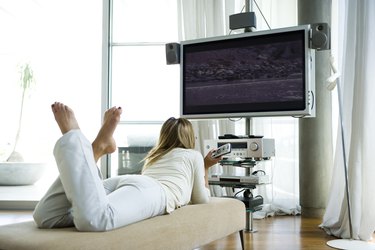
TVs have improved in a lot of ways over the last couple of decades, but their built-in speakers haven't changed much. They'll do if that's what you have, but you'll get better sound using a separate audio system. That might be a modern "home theater in a box," but a traditional old stereo system can be a good upgrade as well. There are lots of ways to connect an old-school stereo system to your TV, depending on the inputs and outputs you have.
Take Stock of Your Options
Video of the Day
Before you decide how to hook up that old receiver to your new HDTV, you need to know what your options are. Either pull out the TV's manual or get behind it and physically look to see what outputs are there. For the old stereo, you may not have the manual anymore, so turn it around to look at the inputs on the back. On the stereo, you'll probably see several sets of inputs using red and white RCA jacks. As long as one of those is free, you're good to go. You may even see a digital audio input, which might look like another RCA connection or else a small plastic optical connector. The outputs on your TV are chancier. A digital audio output is great or at least RCA audio outputs, but you might not be that lucky. You can work with a headphone jack or stereo speaker connections if you have to, or an HDMI output. The worst-case scenario is that your TV doesn't have any output options at all.
Video of the Day
Using Audio Outputs
If you have actual audio outputs, that's the simplest option. To use old-school RCA audio connections, you need a decent RCA cable that's physically long enough to reach from the TV to the back of the stereo. After it's connected, set the stereo to the correct input; a stereo built with A/V use in mind might have one labeled TV/Video, but if not, use whatever's available, and you should hear the sound from your TV. If your TV has a digital output, either the coaxial kind that uses an RCA cable or the optical Toslink kind with the little plastic connector, use that instead. If your receiver has a digital input, it also contains a digital-to-analog converter, or DAC, which can translate from the digital audio out to your analog speakers.
Using Headphone or Speaker Outputs
Using the TV's headphone jack or speaker terminals as your audio output is trickier because those signals are amplified. You can still use them, but you need to be careful of your volume settings: If they're set too high, you can fry your old stereo. Start by buying or making a patch cord that runs from the headphone jack or speaker terminals to the RCA connections on the back of the stereo. Connect them and then turn the volume all the way down. Don't mute it; use the volume down control on your TV. Now, switch the stereo to the input where the TV is connected and set it to whatever would be a normal volume setting if you were listening to music. Slowly increase the TV's volume, until you get a clear, audible volume. Make a note of the volume setting and leave your TV permanently at that level. Use your stereo's remote, instead, to turn the volume up and down.
Using the HDMI Out
Older stereos usually don't have an HDMI connection, so if that's the only output on your TV, you need a bit of help. Your simplest option is to pick up a small external box called an HDMI audio extractor, which isn't hard to find online or at electronics retailers. It splits out the audio portion of an HDMI signal and gives you a set of audio outputs – usually RCA connectors – that you can connect to your stereo.
No Outputs at All
Some HDTVs, especially at the lower price points, have lots of inputs but no outputs at all. That doesn't mean you're completely out of luck, just that you need to be creative. You need to get the audio signal from another piece of equipment. If you receive cable, fiber, satellite or antenna signals through a set-top box, for example, it almost always has a set of audio outputs that you can use.
Bypass the Stereo
If your TV has a headphone jack or speaker terminals, you also have the option of skipping the stereo entirely. Connect the speakers to your TV without the amplifier because a TV with a headphone jack or speaker terminals has its own amplifier – however modest – built in. The amplifier in a headphone jack is only meant to drive the tiny speakers in your headphones, so for that, you'll need powered speakers that contain their own amplification. Speaker sets made for computers are often a good choice because they're designed to work with a headphone jack, and they'll usually give you a subwoofer and a couple of satellite speakers. If you have speaker terminals, you can use conventional unpowered speakers. You'll need to check the manual to learn the recommended impedance, in ohms, for external speakers. Most stereo speakers are 8 ohms, but your TV may be rated for something different. You can safely use speakers with more ohms than your TV calls for, but speakers with a lower ohms rating can cause overheating and damage your TV.